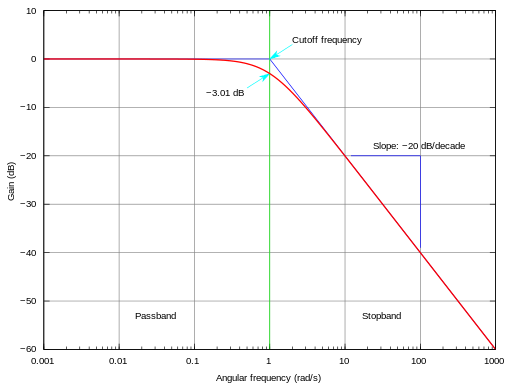Generally, after you've selected your waveforms, the next step you find in your synthesizer is your Filter. Most synthesizers have a low-pass filter, which is the basis of all subtractive synthesis. Some have band-pass, notch, comb, and high pass filters, although it is unlikely you will find much more than a low pass and high pass filter on an analog synth. The picture above shows the frequency response of a low pass filter. If you picture this overlaid on the graph of the frequency spectrum of the sawtooth wave you can get an idea of how this works. The low-pass filter literally means the lower frequencies will be passed through, and the higher frequencies will be filtered out. This same naming principle applies to all filters, as a high-pass lets through higher frequencies, etc.
The easiest way to describe a low-pass sound is to compare it to being underwater, or outside of a club. Only the lower frequencies travel through the water or the walls of the club, so you would only be able to hear the bass and lower mid sounds. Of course, using out filter on the synth allows us to change the cutoff frequency, which means we can make our synth sound like we're under water, or only take away the highest buzz of the wave. The low pass filter can not only be used in the synth, but also for entire sections of a track. Daft Punk, for example, commonly puts a low pass filter on their entire track and slowly raises or lowers the cutoff frequency, giving an effect as if you're entering the club, or emerging from the water. A good example is the track Revolution 909, which features heavy filtering throughout the song. When using the low pass on a synth, a few other parameters are important. For one, the resonance, which is a peak at the cutoff point of your low pass filter, can be changed. If the resonance is turned up all the way, it causes distortion, which is a sound often used by keyboardists. If the resonance isn't turned up too high, it can add to the treble part of your synth sound, and if you are performing filter sweeps (i.e. having a sound thats cutoff frequency changes over time), adding resonance can highlight that this is occurring. Most synths also have a keyboard parameter, which somewhat maps the cutoff frequency to the key number pressed. This allows you to have a consistent cutoff for sounds, making a synth sound more dynamic. Without the keyboard parameter for the filter, a heavily filtered sound would barely be useable in the higher regions of the keyboard and only sound good in the lower sections.
Don't forget that you can also change the filter cutoff with an envelope. Many famous synth sounds use this technique by having the cutoff slowly rise or fall, or quickly cutoff to get different thump sounds, which makes your synth patch all the more realistic for something like a bass. It's important to experiment with these parameters with your synthesizer, and find out what sounds coolest to you.
The other filter sound I'll cover for now is the high pass. The high pass filter sound can help eliminate bassier sounds from your patch. I'm no expert on the high-pass, but it does have a similar sound to a small radio. For example, if you wanted to have your track sound like it was being played at a basketball court from a boombox, you could highpass it to the desired frequency (because boomboxes generally lack good bass) and add the sounds of the court. The same idea works for the sound of an old car radio. Cut the bass and add sound effects, and you're well on your way.
As always, feel free to email thesynthesizersympathizer@gmail.com with requests or follow us on Twitter.
For a quick way to get great patches, try this book:


No comments:
Post a Comment